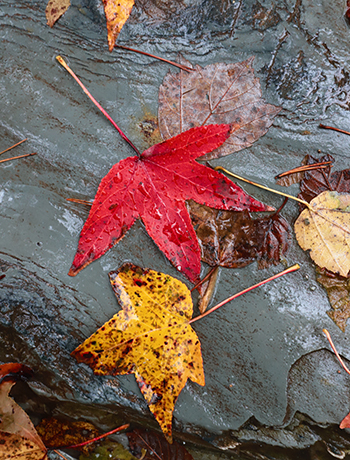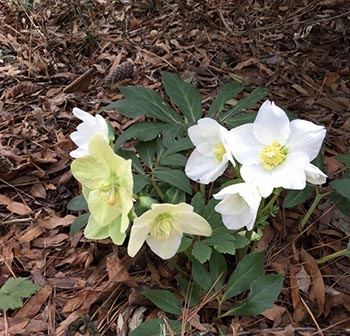Garden Talk

Letting Leaves Lie
By Katherine Hale

As the days shorten and temperatures drop, many of us find ourselves engaged in autumn traditions, such as Thanksgiving dinner, quality time with family, pumpkin spice on everything, and putting the garden to bed for the winter. This year, take a “leaf” out of Mother Nature’s book and consider “leaving the leaves” to add all those nutrients back into the soil.
As a naturally occurring mulch, fallen leaves help keep the ground underneath moist even during dry spells and droughts, reducing the need for watering. They also provide important habitat for many beneficial insects, as well as the birds and mammals that depend on them. Leaves are the backbone for our entire ecosystem—removing them is like pulling out the battery from your phone and expecting it to function well. It might be able to limp along for a bit, but it quickly ends up empty and dead.
As Annabel Renwick, curator of the Blomquist Garden of Native Plants, summed it up succinctly in a recent virtual "Walk on the Wild Side": “Bottom line, it is important to keep the leaves.”
Here at Duke Gardens, we remove leaves from lawns to keep turfgrass healthy, but we blow or rake it into nearby wooded or mulched areas to keep them on site. Paths and walkways are cleared of leaves, but any that fall into naturalized or forested sections are allowed to remain in place to nourish the soil. Homeowners might find grinding up their leaves with a lawnmower sufficient for their lawns, or they may find they prefer composting the leaves for six to twelve months before putting the finished product back into the garden.
Not only do these practices keep so-called “litter” from cluttering up the landfill — where they take up space and release potent greenhouse gases like methane — they also create a free, slow-release fertilizer boost for grasses and nearby perennials. Alternatively, consider swapping out some or all of your turfgrass for perennial beds or wildflower meadows, which are less impacted by falling leaves.

Many municipalities, including Durham, have special brown bins for “yard waste” and other organic matter, in order to divert this nutrient-rich resource to a giant compost pile in lieu of a landfill. If you simply must get rid of all of your fallen leaves, this is the most eco-friendly option, but it’s far less work for both you and the city — and healthier for your garden as a whole — if the leaves remain where they are.
If removing leaves is completely unnecessary, and sometimes even harmful to our landscapes, why do we do it? Maybe we like how tidy and neat a freshly raked lawn looks, even if it’s only for a few moments before the next gust of wind. Perhaps home improvement stores, with their assortment of rakes, leaf blowers, and 30-gallon paper bags with clever slogans, are driving our decisions. Or perhaps it’s tradition — we do it because that’s what we’ve always done.
But traditions aren’t hard and fast rules, especially when they come with unforeseen consequences, and it’s time for us to make some thoughtful changes for the better. As a bonus, these eco-friendly changes are generally less labor intensive than any alternatives, and they leave us with more time for the things that really matter in our lives.
So this fall, consider retiring your leaf bags, and swap out your rake and leaf-blower for a round with your lawn mower, or compost your leaves to add back into the garden later. Or let go entirely of the desire for a pristine expanse of bare ground, and make a new tradition: harness the power of nature to work for you by embracing the vibrant diversity of a living landscape and relaxing with a cup of tea or a mug of cocoa.
Photos from top: Autumn leaves in the Culberson Asiatic Arboretum by Cathi Bodine; fallen leaves on a stone in the Culberson Asiatic Arboretum, by Brian Wells; Christmas rose (Helleborus niger 'HGC Josef Lemper') thriving in a bed of fallen leaves, by Orla Swift.





